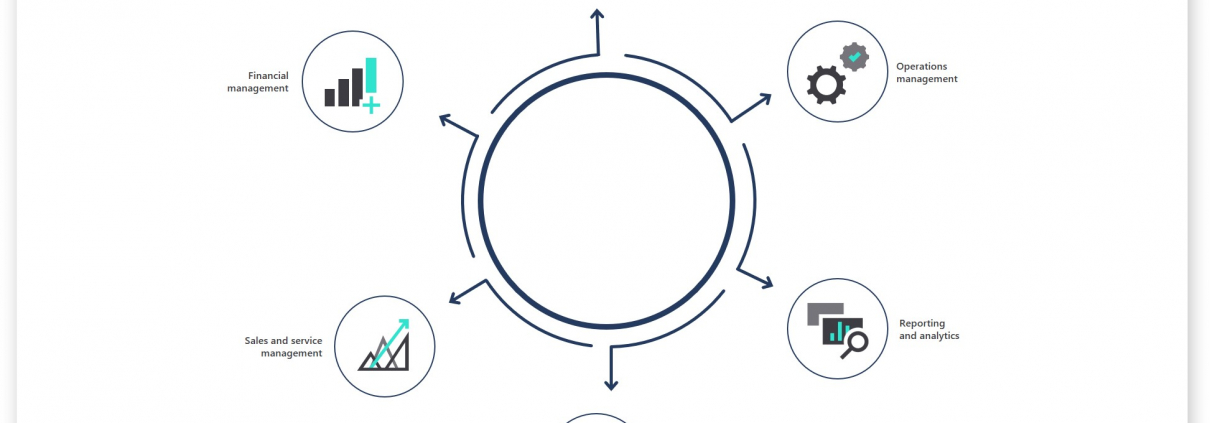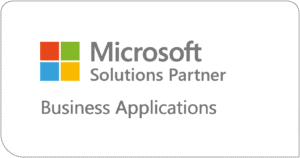How to Select Business Management Solution for Your Company in Malaysia
As a leader within a small to medium-sized business (SMB), your responsibilities are boundless. Each day, pushing your business vision forward means stepping into whatever role is needed in the moment—sales, marketing, human resources (HR), accounting, purchasing, customer service, or investor relations— sometimes all at once.
When everything is moving so fast and you are constrained by time and resources, it can be difficult to stop and think about the business systems that your operations rely on.
DOWNLOAD OUR SAVVY SMB LEADER’S BUYER GUIDE
This guide is designed to help you determine if a modern cloud business management solution can help you address the current gaps in your operations and to provide best practices and strategies for embracing digitalization.
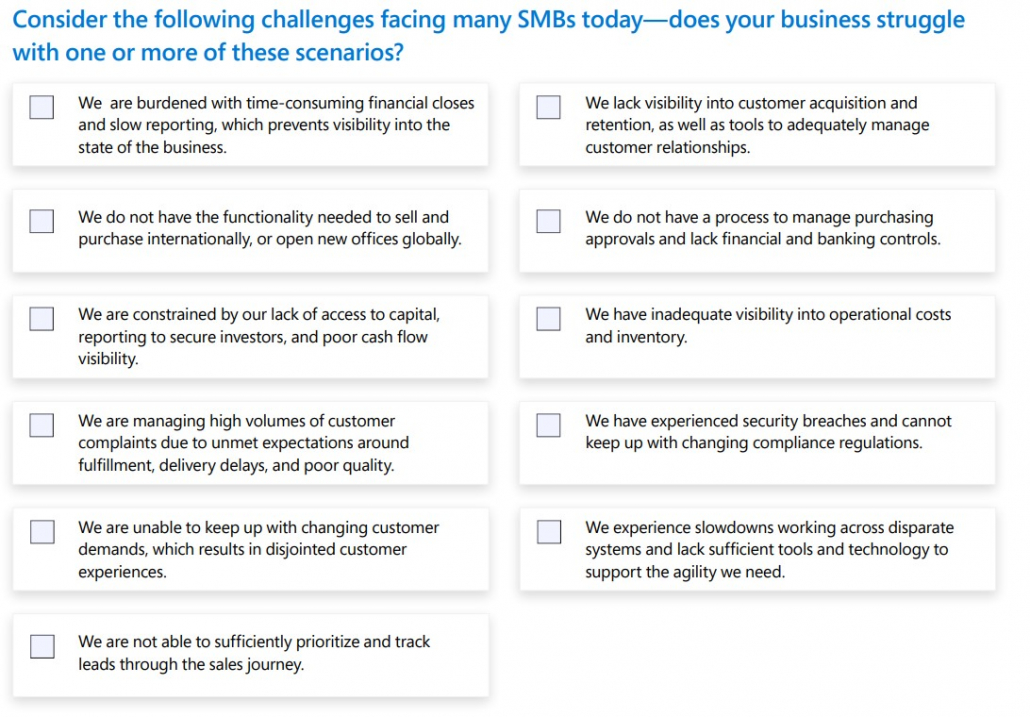
(Download our guide here for interactive version, where you can tick the boxes and leave notes.)
This information is for you if:
- You are a small to medium-sized business leader that is looking to embrace digitalization, but you are not sure where to start your journey.
- You are new to business management or enterprise resource planning (ERP) software and are looking to understand more about how the right technology platform can help you achieve your vision.
- You are looking for ways to solve critical business issues that are impacting business performance.
- You are looking for a digital transformation partner that will help you achieve optimal outcomes, while minimizing business disruption.
What is modern cloud business management software?
The wave of rapid digitalization in recent years has brought significant changes to our everyday lives, with technology advancements enabling a fully connected world commanded by cloud-based, mobile functionality.
This evolution has not only changed the way people interact but has changed expectations around how we do business.
While SMB leaders have long relied on legacy applications and disparate solutions to manage their business needs, they are now facing a pivotal moment where embracing digital transformation is quickly becoming essential to survival.
In fact, 84 percent of SMB leaders agree that technological changes are reshaping the industry and requires reimagining of their business models.
The new generation of cloud-based, comprehensive business management software is designed specifically to make digitalization more accessible than ever for SMBs, helping them capitalize on new technology to adapt faster, work smarter, and perform better.
Connecting data across financials, sales, service, supply chain, and operations provides a holistic view and deeper insight into what is happening within and around the business while enabling more informed action.
DOWNLOAD OUR SAVVY SMB LEADER’S BUYER GUIDE

How does modern business management software differ from entry level accounting, customer, or resource management tools?
Traditional technologies like bookkeeping and accounting tools, customer relationship management (CRM), and ERP solutions, and human capital management (HCM) applications are each effective in helping SMB leaders manage various aspects of their business.
However, these disparate systems leave data siloed and inaccessible without providing a holistic “big picture” of everything happening across the business. A modern, all-in-one business management solution brings together the functionality of all these applications in a single source to connect your data, people, and processes for maximum business impact with less effort.
Modern business management software enables you to:
- Automatically pull your systems and processes together so your people do not have to.
- Gain a complete picture from across your business, with reports when and where you need them, to support more informed decisions .
- Create efficiency across your business processes and be ready for growth so change does not get in the way of your day-to-day operations.
How can modern business management software help?
Business continuity and success depend on effective operations, productivity, quality, speed, and the customer experience that you deliver.
However, the traditional strategies and multitude of solutions SMBs have long relied on to support these efforts are no longer sufficient in keeping pace with today’s rapidly changing and digitally-driven economy.
Modern business management solutions—rooted in cloud technology—help to fill the gaps and connect your data across all lines of business in your organization.
From financials to sales, services to projects, and even across warehousing, supply chain, and manufacturing, a modern solution can enable real-time data access, visibility, and insights across your entire business.
The result is a digitally reimagined business that provides you with a competitive edge. Modern business management software can help you:
- Increase financial visibility to support more informed decisions with connected data and real-time reporting, streamlined financial closing, and financial performance tracking.
- Go global with custom financial dimensions and multi-company, multi-lingual, multicurrency fixed asset management.
- Optimize your supply chain with a holistic view of inventory, predictive restocking suggestions, streamlined receiving, and proactive engagement with suppliers.
- Accelerate sales by prioritizing leads, optimizing pricing, and central management of all agreements and sales orders.
- Improve service and deliver end-to-end customer experiences with centralized customer records and effective management of post-sales issues.
- Deliver projects on time and on budget with advanced tracking and reporting to enable better resource management and more effective, insight-based decisions.
- Improve agility and productivity with a consolidated system and work-from-anywhere access to business data and tools.
- Strengthen security to protect your organization from data breaches and maintain compliance.
- Take your business on the go with any time, anywhere access on any device.
- Be ready for growth with a solution that is always up to date and can also be tailored and adapted to fit your unique needs.
Buying a business management solution
With numerous business management and ERP solutions available on the market, selecting the right one for your company can seem like a daunting task—but it does not have to be.
Through a series of easy-to-navigate steps, the E.M.P.O.W.E.R. process provides the necessary guidance to move your business from envisioning to realizing results with a solution that fits your needs.

(Download our guide here for the interactive version, where you can tick the boxes and leave notes.)
Step 1: Define and prioritize your digitalization strategy, identifying the problems you wish to address and what business outcomes you hope to achieve. Spend some time considering the impact a new cloud ERP could offer across your business.
Step 2: Once you have your strategy outlined, it is critical to assign an executive sponsor and clearly articulate roles and responsibilities for the project. Ensure each team member knows their role, understands the strategy, and knows how to initiate a change in the process.
Step 3: Start short-listing and comparing vendors at the beginning of your buying process. The right partner will help you maximize your digitally transformed processes and ensure continued future growth as your technology and your organization evolve.
Step 4: Modern ERP provides an array of capabilities across many lines of business and functions. Identifying the business and process outcomes that will define success will help you map the critical capabilities that are essential in supporting your desired results.
Step 5: Leverage the work completed in the previous steps to build a compelling case for change, considering the business and technological impact, quantifying the return on investment (ROI) and financial benefits, and establishing a timeline and plan for implementation.
Step 6: Accelerating organizational agility requires attention across five dimensions: strategy, structure, process, people, and technology. Help your organization see the value in your business transformation by creating immersive experiences across all five dimensions.
Step 7: Modern business management systems provide an array of capabilities across many lines of business and functions. Identifying the business and process outcomes that will define success will help you map to the critical capabilities that are essential in supporting your desired results
Envisioning digital transformation
Use the following template to help you outline your digital transformation strategy. Be sure to include an approach for all of your departments. We’ve provided a few examples to get you started:

(Download our guide here for interactive version, where you can tick the boxes and leave notes.)
Managing change
As Benjamin Franklin once articulated, “By failing to prepare, you are preparing to fail.” Every successful project starts with a detailed plan of action.
When buying a new business management or ERP solution, that includes a plan for managing change. Forging ahead without carefully outlining dependencies, roles, and responsibilities could easily jeopardize the success and impact of your new solution.
Over 70% of transformational change efforts fail due to lack of sufficient leadership, communication, and organization-wide buy-in.
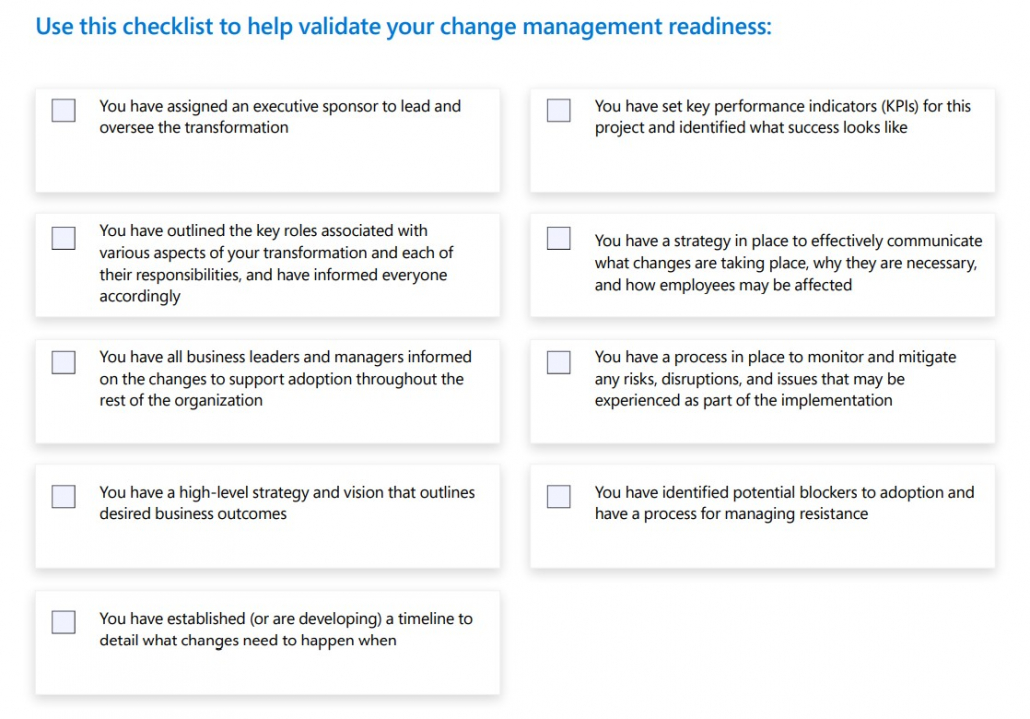
(Download our guide here for interactive version, where you can tick the boxes and leave notes.)
Partner selection
With hundreds of business management solutions available today, it can be challenging to know where to start your search. Even before looking at specific capabilities, the first step should be determining what is important to you in a technology vendor.
With the right partner and the right solution, even complex business processes can be transformed with confidence.


(Download our guide here for interactive version, where you can tick the boxes and leave notes.)
Outcome to critical capabilities mapping
Modern cloud business management systems provide an array of functions across financials, sales, customer service, projects, warehousing, inventory and supply chain, manufacturing, and business intelligence. The right solution should not only provide the capabilities you need to reimagine your day-to-day operations today, but also support the needs that may arise tomorrow.
As a rule, organizations should aim to get at least 80 percent of the functionality they need from a business management solution “right out of the box,” without needing to make any significant modifications.
This leaves the remaining 20 percent to come from solutions from independent software vendors (ISVs) and other custom applications to fine tune the solution to meet any highly specific capabilities. In other words, the solution you select should be one that is pre-configured to include nearly all the capabilities you need from day one.
However, buying a business management solution is not about ensuring it has every feature available in market today—you should focus on getting the right capabilities to drive process innovation and support the business outcomes defined in your initial strategy
DOWNLOAD OUR SAVVY SMB LEADER’S BUYER GUIDE

Here are some of the business outcomes and capabilities that a business management solution can support:
- Increase financial visibility and make more informed decisions with better reporting and tracking. Support custom financial dimensions, intercompany transactions, automatic bank reconciliations, fixed assets, cost accounting, financial performance indicators—all while adhering to strict financial standards.
- Optimize your supply chain with a holistic view of inventory, purchases, and orders. Predict restocking needs and engage with suppliers while improving demand forecasting, drop shipments, order planning, purchasing governance and logistics, warehousing optimization, manufacturing production, assembly, and quality management.
- Boost sales with lead prioritization and improved customer relationships through contact, campaign, document, email, opportunity, and sales order management. Easily expand to full CRM functionality when needed.
- Improve customer service with enhanced planning and dispatching while streamlining contract, service order, and price management. Better address customer returns and needs to improve satisfaction.
- Deliver projects on time and on budget with improved resource management— including time and expense tracking, people, and materials—to make effective, insightbased decisions through advanced reporting.
- Increase agility with the ability to work and connect to business data and tools from anywhere. Access your data no matter where it lives—across cloud, on premises, or IoT—and easily add new users, new companies, new financial dimensions, or additional storage.
- Enhance productivity through workflow automation and governance, with connectivity to familiar business tools like Outlook, Teams, and Excel to increase ease of use and adoption. Leverage role-based advice and guidance to ensure users have the right access to the right information.
- Go global with cloud availability and multi-language, multi-currency support that adheres to local regulations and taxes.
- Maximize value with extensibility and customization to fit your unique needs through app development, business intelligence dashboards, business process optimization, chatbots, and connectivity to ISV solutions.
- Support future-readiness and growth with an always-on, always up-to-date cloudbased solution that can scale as you grow and provides the modern analytics and artificial intelligence capabilities that the future of business requires.
- Protect your business with increased, cloud-based security and compliance that keeps your data and custom apps protected while enabling business continuity.
With these outcomes and high-level capabilities in mind, take some time to look at your current business processes and create process maps to identify friction points and bottlenecks.
Challenge your teams to ideate on how to transform these processes, like leveraging automation to reduce the number of steps and manual action required. Have your teams consider how technology might drive efficiencies and identify the transformed business outcomes you would like to achieve. You can then begin to map your ideal outcomes to the necessary capabilities in a business management solution.
Procure to pay process map
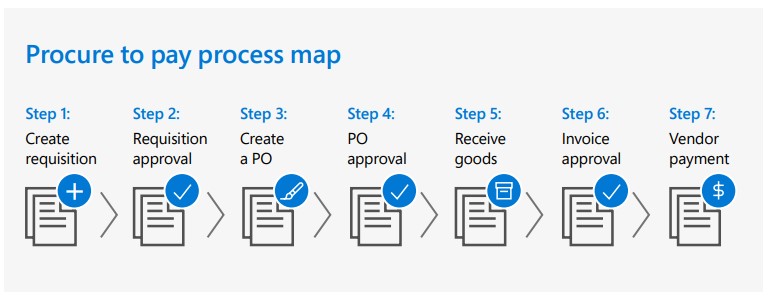
Writing a business case
Building an effective business case for a cloud business management solution can help you not only identify the ROI with a direct cost-to-benefit ratio but can help you demonstrate the business value to gain buy-in from your leadership team and employees. The following worksheet will help you get started when developing your business case:
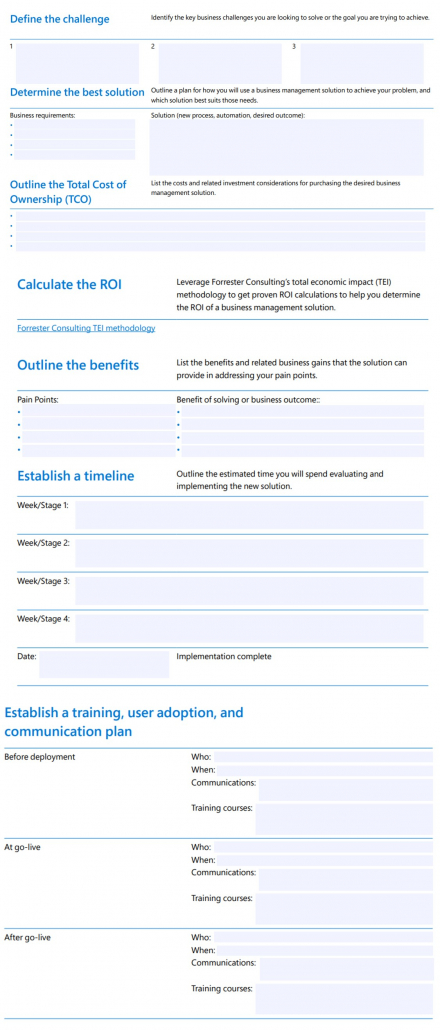
(Download the guide with the template inside here)
Leverage change management
Apply ERP change management best practices to ensure buy-in and user adoption across the business.
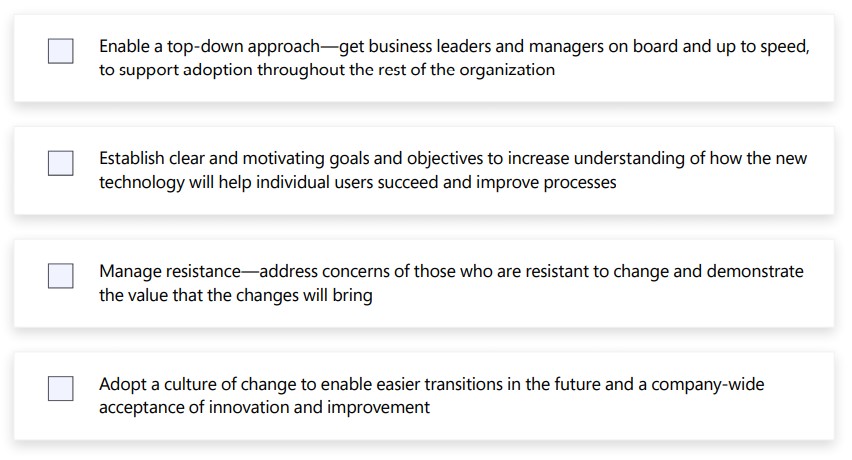
(Download our guide here for interactive version, where you can tick the boxes and leave notes.)
Embracing digitalization
Setting yourself up for success is about more than just the right technology. It is about your overall digitalization strategy, process mapping, and most importantly—your people.
A successful transformation means ensuring that your plan accelerates organizational agility throughout your business and across each of these five dimensions:
Strategy
To be successful, your digitalization strategy needs to create a shared purpose and vision across all teams within the organization. As outlined in Envisioning digital transformation, be sure to document your strategy and create visualizations to get everyone excited about the outcomes a new approach will drive for them, your customers, and the business.
Structure
Teaming, or how your teams operate in supporting customer outcomes, is essential to your business success. Your organizational structure needs to empower team alignment, accountability and collaboration. It is important to create role clarity and outline the expertise that is required to drive business impact. This can often require reskilling of employees to move your strategy forward.
Processes
Continuous process optimization is iterative innovation that every single person in your company needs to be accountable for driving. Employee engagement and retention is improved when people feel a sense of ownership and are rewarded for recommending changes that will improve departmental KPIs.
Help encourage both adoption and process optimization in your digitalization strategy by tracking operational performance metrics tied to departmental processes.
People
Thriving in a rapidly changing market requires that every person in your business be able to adapt quickly to new ideas, products, and business models. Agility and adaptability are becoming the new measure of aptitude. Historically, companies focused on experience and expertise, or what is referred to as a person’s “Intelligence Quotient” (IQ).
The new focus on digital advancement and agility has introduced the “Adaptability Quotient” (AQ), which measures a person’s ability to embrace change with an open mindset. There are ways to help your people improve their AQ to become more instrumental in driving innovation.
Technology
Technology is advancing rapidly, resulting in constantly evolving markets and customer expectations. Technology may be the foundation, but it is put into action through your strategy, structure, processes, and people.
The most important part of this dimension is to keep from getting stuck on outdated platforms or legacy software that does not adapt with you as you change and grow. Simply implementing your initial digitalization strategy is not where you stop—adopting a culture of change makes for easier transitions to future technology and instills a company-wide acceptance of continuous innovation and improvement. Ensure your business management solution is as adaptable as your business and will grow with you.
Realizing results with Microsoft Dynamics 365 Business Central
To make your business dreams a reality, you need business solutions to keep pace with a constantly changing world. That is why successful SMBs have moved to the cloud with Microsoft Dynamics 365 Business Central. Now more than ever, SMBs need to embrace digitalization, because “business as we know it” has changed.
Expectations have changed. The customer experience has changed. Even where and how we work is changing right before our eyes. Yet so many businesses remain limited by systems that simply do not allow for change.
That is where the next evolution of Microsoft Dynamics NAV, GP, and SL can help—enabling SMBs to become powered by the cloud, powered by connected data, and powered by business intelligence.
Bringing together the productivity of Microsoft Office 365; the data connectivity and business intelligence of the Microsoft Power Platform; and the security, scale, and geographic presence of Microsoft Azure; Dynamics 365 Business Central delivers a single, unified application that connects business management across finance, sales, service, supply chain, distribution, and manufacturing.
The result? A business that can adapt faster, work smarter, and perform better.
Adapt faster
Move to the cloud with confidence to adopt new business models faster with flexible deployment options and innovative solutions that grow alongside your business.
Work smarter
Connect people, processes, and insights to make better decisions quicker while optimizing productivity with embedded guidance interoperable with Office 365 and Teams.
Perform better
Increase business visibility and performance to close your books faster, get reports sooner, and obtain real-time cash flow and performance metrics at any time on any device.
Back to You
Today’s marketplace is not just competitive, it is constantly changing. With every day and every minute bringing something new, be equipped for what is next and unlock limitless possibilities with Dynamics 365 Business Central.
Agile Dynamics Solutions is the leading Microsoft Partner in Malaysia, providing Microsoft Dynamics 365 and Azure services for business across SEA. Request a demo now or learn more about Dynamics 365 Business Central.
DOWNLOAD OUR SAVVY SMB LEADER’S BUYER GUIDE


